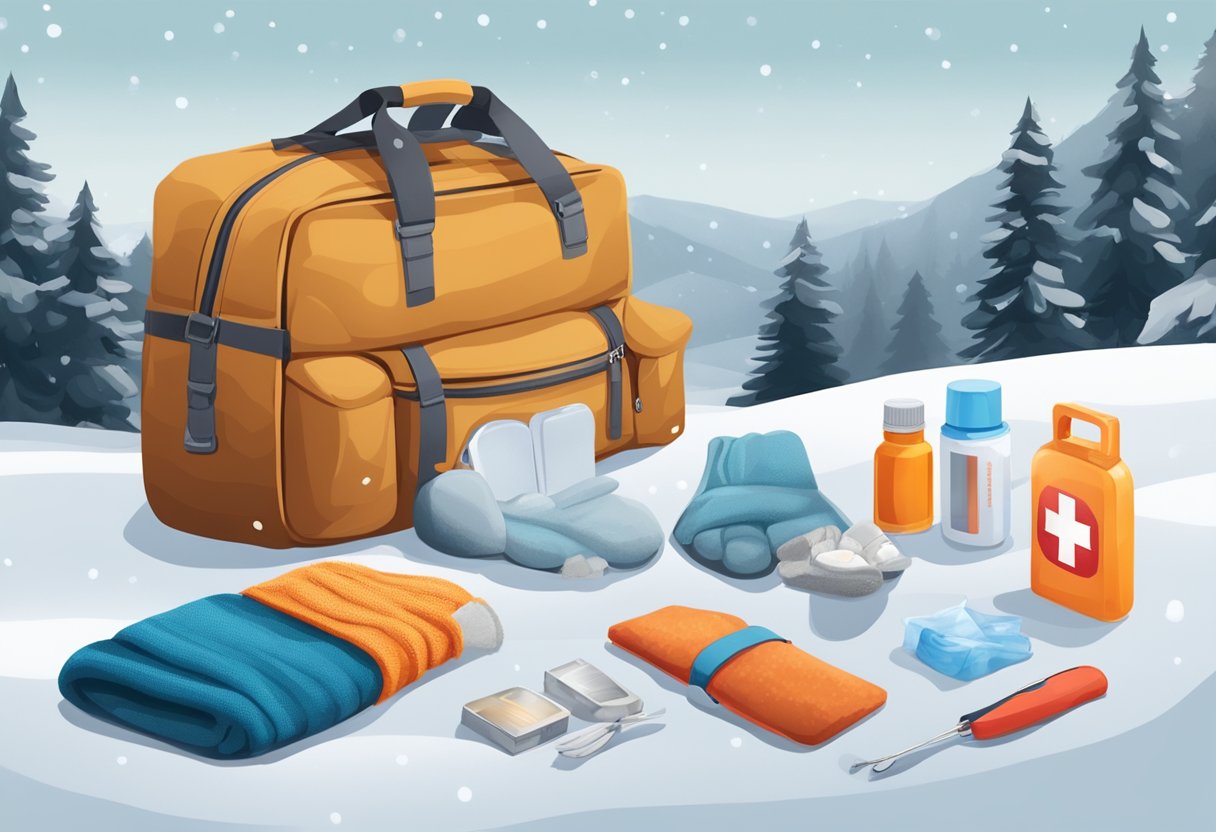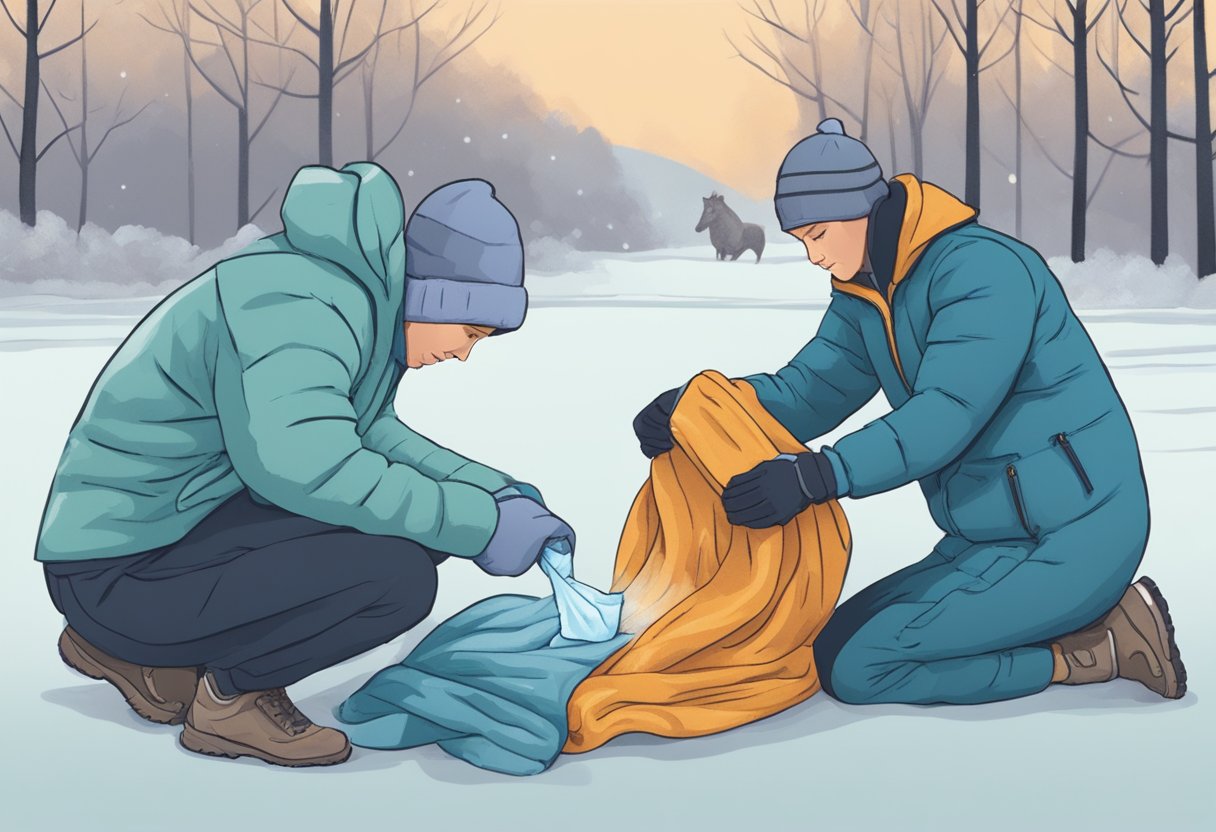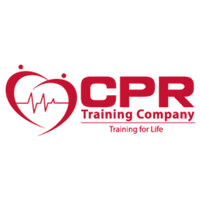Winter first aid basics include being able to recognize and treat common cold-related injuries such as frostbite and hypothermia. Hypothermia occurs when the body loses heat faster than it can produce it, while frostbite occurs when the skin and underlying tissues freeze. It is important to know the signs and symptoms of these conditions and how to treat them promptly. Additionally, it is important to take preventative measures such as dressing in layers and staying dry to avoid these conditions altogether.

Key Takeaways
- Winter first aid basics include recognizing and treating common cold-related injuries such as frostbite and hypothermia.
- Preventative measures such as dressing in layers and staying dry can help avoid cold-related injuries.
- Special considerations should be taken for vulnerable populations such as the elderly, children, and those with pre-existing medical conditions.
Winter First Aid Basics
Winter can be a beautiful and magical season, but it can also be a treacherous one. Snow, ice, and freezing temperatures can create hazardous conditions that increase the risk of injury and illness. To stay safe during the winter months, it is important to be prepared with the right knowledge and tools. This section will cover some winter first aid basics that everyone should know.
Understanding Hypothermia and Frostbite
Hypothermia and frostbite are two of the most serious conditions that can occur in cold weather. Hypothermia occurs when the body's temperature drops below 95°F (35°C) and can lead to shivering, confusion, and even loss of consciousness. Frostbite occurs when the skin and underlying tissues freeze, usually affecting the extremities such as fingers, toes, ears, and nose. It can cause numbness, tingling, and even permanent damage.
Layering and Insulation Techniques
One of the most important things to do to protect against hypothermia and frostbite is to dress properly. Layering is key, as it allows for flexibility in adjusting to changing temperatures. The first layer should be a moisture-wicking material to keep sweat away from the skin. The second layer should be an insulating material such as wool or fleece to trap heat. The outer layer should be windproof and waterproof to protect against the elements.
First Aid Kit Essentials for Winter
Having a well-stocked first aid kit is essential for any outdoor activity, especially during the winter months. Some items to include in a winter first aid kit are:
- Blankets or emergency blankets to help retain body heat
- Chemical hand warmers to provide heat to extremities
- Hot packs to warm up frozen areas
- Sterile gauze pads and adhesive bandages for cuts and scrapes
- Tweezers to remove splinters or ticks
- Pain relievers for aches and pains
- A first aid manual or guide
It is important to remember that in cases of severe hypothermia or frostbite, immediate medical attention is necessary. Call 911 or seek medical help as soon as possible.
Preventing and Treating Cold-Related Injuries

Winter weather can be dangerous, and it is important to take precautions to prevent cold-related injuries. When working or exercising outdoors in cold temperatures, it is important to dress appropriately, stay dry, and take breaks to warm up. If someone does experience a cold-related injury, it is important to recognize the symptoms and respond quickly.
Frostbite Recognition and Response
Frostbite is a serious cold-related injury that occurs when skin and other tissues freeze. It most commonly affects the fingers, toes, ears, nose, chin, and cheeks. Symptoms of frostbite include numbness, tingling, or a burning sensation, followed by skin that turns white or grayish-yellow. In severe cases, the skin may turn black and become hard and waxy.
If someone is showing signs of frostbite, it is important to get them out of the cold and into a warm place as soon as possible. Remove any wet clothing and gently warm the affected area with warm water (not hot). Do not rub or massage the area, as this can cause additional damage. Seek medical care if the person is showing signs of confusion, slurred speech, or weakness.
Hypothermia Prevention and Management
Hypothermia occurs when the body's temperature drops below normal due to exposure to cold temperatures. Symptoms of hypothermia include shivering, confusion, slurred speech, and weakness. In severe cases, hypothermia can lead to loss of consciousness and even death.
To prevent hypothermia, it is important to dress appropriately for the weather, stay dry, and take breaks to warm up. If someone is showing signs of hypothermia, it is important to get them out of the cold and into a warm place as soon as possible. Remove any wet clothing and cover the person with dry clothing or blankets. Apply hot packs to the neck, armpits, and groin to help warm the body. Seek medical care immediately.
Overall, it is important to take cold-related injuries seriously and respond quickly to prevent further damage. By taking the appropriate precautions and responding quickly to injuries, individuals can stay safe and healthy during the winter months.
Special Considerations for Vulnerable Populations
Winter can be a difficult time for everyone, but it can be especially challenging for vulnerable populations such as children and the elderly. It is essential to take extra precautions to ensure their safety during the colder months.
Children and Winter Safety
Children are more susceptible to hypothermia and frostbite because they have a higher surface area-to-body mass ratio than adults. They can lose heat more quickly, and their bodies may not be able to regulate their temperature as effectively. Therefore, it is important to keep children warm and dry during the winter months.
Parents should dress their children in layers of warm clothing and ensure that they are wearing appropriate footwear. Children should avoid playing in the snow for extended periods to prevent loss of feeling and color in their extremities. Parents should also be mindful of the signs of hypothermia and frostbite, such as shivering, confusion, and loss of feeling, and seek medical attention immediately if necessary.
Elderly Care in Cold Weather
Older adults are also at higher risk for hypothermia and frostbite, as well as heart and circulation problems. Therefore, it is essential to take extra precautions to ensure their safety during the winter months.
Older adults should dress appropriately for the weather and avoid going outside in extreme cold temperatures. They should also stay warm and insulate their homes to prevent heat loss. It is also important to ensure that they have access to medical attention in case of a medical emergency.
Overall, taking safety precautions and being mindful of the needs of vulnerable populations during the winter months can help prevent health problems and ensure their well-being.
Frequently Asked Questions
What are the signs and symptoms of hypothermia?
Hypothermia is a medical emergency that occurs when the body temperature drops below 95°F. Symptoms of hypothermia include shivering, confusion, drowsiness, slurred speech, and loss of coordination. In severe cases, the person may experience shallow breathing, a weak pulse, and unconsciousness. If you suspect someone has hypothermia, it's important to seek medical attention immediately.
How do you treat frostbite in a winter environment?
Frostbite is a cold-related emergency that mostly affects extremities such as fingers, toes, ears, and face. The first step in treating frostbite is to get the person out of the cold and into a warm environment. Remove any wet clothing and wrap the affected area in a warm blanket or clothing. Do not rub the affected area, as this can cause further damage. It is important to seek medical attention as soon as possible.
What are the key steps in administering first aid for cold-related emergencies?
The key steps in administering first aid for cold-related emergencies include removing the person from the cold environment, removing any wet clothing, and wrapping the person in warm blankets or clothing. It is important to monitor the person's breathing and circulation and to seek medical attention as soon as possible.
What should be done to provide first aid in winter sports injuries?
Injuries can occur while participating in winter sports such as skiing, snowboarding, and ice skating. The first step in providing first aid for winter sports injuries is to assess the extent of the injury and to stabilize the affected area. It is important to immobilize the affected area and to seek medical attention as soon as possible.
What are the recommended precautions when providing first aid in extremely cold weather?
When providing first aid in extremely cold weather, it is important to protect yourself from the cold. Wear warm, dry clothing and cover your head, hands, and feet. It is also important to stay hydrated and to take breaks in a warm environment if necessary.
How can one recognize and treat closed wound injuries in cold conditions?
Closed wound injuries occur when there is damage to the underlying tissue without a break in the skin. In cold conditions, it is important to recognize the signs of a closed wound injury, which can include pain, swelling, and discoloration. Treatment for closed wound injuries includes applying ice to the affected area and elevating the affected limb. It is important to seek medical attention if the injury is severe or if there is any sign of infection.
